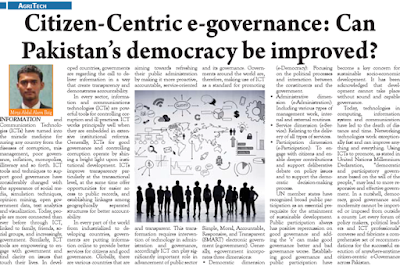Information and Communication Technologies (ICTs) have turned into the miracle medicine for curing any country from the diseases of corruption, mismanagement, poor governance, inflation, monopolies, illiteracy and so forth. ICT tools and techniques to support good governance have considerably changed with the appearance of social media, simulation techniques, opinion mining, open government data, text analytics and visualization. Today, people are more connected than ever before through ICT, linked to family, friends, social groups, and increasingly, government. Similarly, ICT tools are empowering to engage with government and find clarity on issues that touch their lives. In developed countries, governments are regarding the call to deliver information in a way that create transparency and demonstrates accountability.
In every sector, information and communications technologies (ICTs) are powerful tools for controlling corruption and ill practices. ICT works principally well when they are embedded in extensive institutional reforms. Generally, ICTs for good governance and controlling corruption operate by shining a bright light upon institutional development. ICTs improve transparency particularly at the transactional level, at the same time offer opportunities for easier access to public records, and establishing linkages among geographically separated structures for better accountability.
In every part of the world from industrialized to developing countries, governments are putting information online to provide better services for citizens and good governance. Globally, there are various countries that are aiming towards refreshing their public administration by making it more proactive, accountable, service-oriented and transparent. This transformation requires intervention of technology in administration and governance, accordingly ICT can play significantly important role in advancement of public sector and its governance. Governments around the world are, therefore, making use of ICT as a standard for promoting Simple, Moral, Accountable, Responsive, and Transparent (SMART) electronic government (e-government). Generally, e-government incorporates three dimensions:
• Democratic dimension (e-Democracy): Focusing on the political processes and interaction between the constituents and the government.
• Administrative dimension (e-Administration): Including various types of management work, internal and external routines.
• Service dimension (e-Service): Relating to the delivery of all types of services.
• Participation dimension (e-Participation): To engage with citizens and enable deeper contributions and support deliberative debate on policy issues and to support the democratic decision-making process.
UN member states have recognized broad public participation as an essential prerequisite for the attainment of sustainable development. Public participation always has positive repercussion on good governance and adding the ‘e’ can make good governance better and bad governance worse. Establishing good governance and public participation have become a key concern for sustainable socio-economic development. It has been acknowledged that development cannot take place without sound and capable governance.
Today, technologies in computing, information system and communication have led to the death of distance and time. Networking technologies work exceptionally fast and can improve anything and everything. Using ICTs to promote, as stated in United Nations Millennium Declaration, “democratic and participatory governance based on the will of the people,” may lead to more responsive and effective government. In a nutshell, democracy, good governance and modernity cannot be imported or imposed from outside a county. Let every forum of policy makers, political leaders and ICT professionals’ converse and fabricate a comprehensive set of recommendations for the successful execution of anywhere-anytime citizen-centric e-Governance across Pakistan.



No comments:
Post a Comment